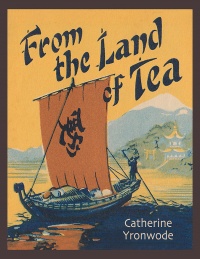From Mystic Tea Room
England Tea Room Gallery, in alphabetical order by name of city or town.
In this installment of "From the Land of Tea," we take a sneak-peek look at an upcoming page that will eventually be on display to the public. As a Patreon supporter, you have access to the page one full year before the public does.
- Patreon Release Date: November 28th, 2021.
- Public Release Date: November 28th, 2022.
Please tell your friends that they can subscribe to my Patreon stream for $2.00 per week:
Patrons: To discuss this and other Patreon pages with me, join my private Patreon Forum:
Today's topic is again Tea Rooms by Location. These are old postcards, and each one has a caption explaining it, and some have additional text. These images will eventually be on display at the Mystic Tea Room web site. As a Patreon supporter, you have access to them one full year before the public does.
To place this work in context, please read the following introductory pages
England
English tea rooms are among the oldest found outside of Asia. Their popularity predated the great Tea Room craze of 1895 to 1945, but like their American counterparts, they were often retrofitted into historical buildings, including cottages, houses, barns, granaries, mills, inns, taverns, and hotels. Because England is a region of cold and damp winters, these older buildings were often outfitted with fireplaces in every room, and thus, in England at least, a fireplace was to be found in almost every tea room.
The word most often used to describe such tea rooms is "cozy" -- and cozy is a word whose literal meaning is "warm." When postcards were made to publicize such local tea rooms, it was quite natural for the photographer to focus on the fireplace or to feature it prominently in the composition.
Not all of the tea room postcards in this lot are interior views, but those that are often contain fireplaces. Many of these cards are also RPPCs -- real photo postcards.
Cornwall
Penzance
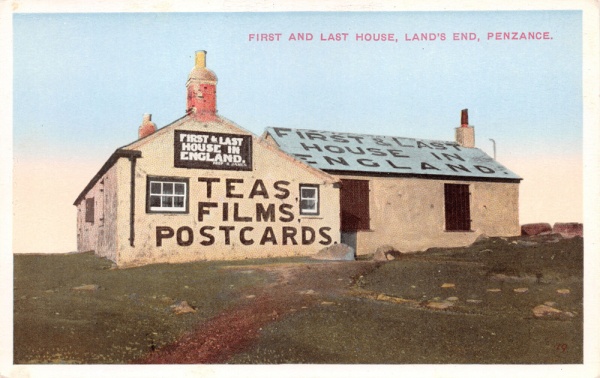
First and Last House in England, Land's End, Penzance, Cornwall, England, offering Teas, Film, and Postcards. The First and Last House in England is an unusual tourist destination; the name refers to the fact that it is the farthest west structure on the island, and thus to first to be sighted when approaching England from the Atlantic Ocean and the last to be seen when sailing west. Signage on the exterior walls and roof has changed many times over the past 100 years, but tea is always available, and in summer there are ices. This photo was probably taken and tinted in the 1920s, and the building still stands.
Polperro
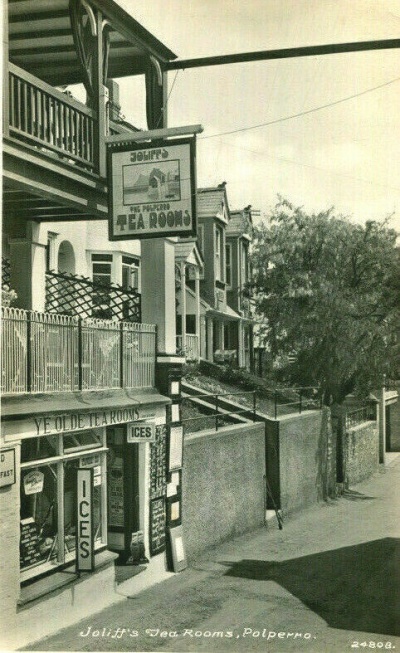
Joliff's Polperro Tea Rooms, Polperro, Cornwall, England. This exterior photo of signage for "Joliff's, The Polperro Tea Rooms" and "Ye Olde Tea Rooms" selling "Ices" displays the quaint architecture of this seaside town. The card dates to the 1910s or 1920s and a quick glance at Google street view shows that the building and row of houses was still standing 100 years later, in 2021.
Devon
Braunton
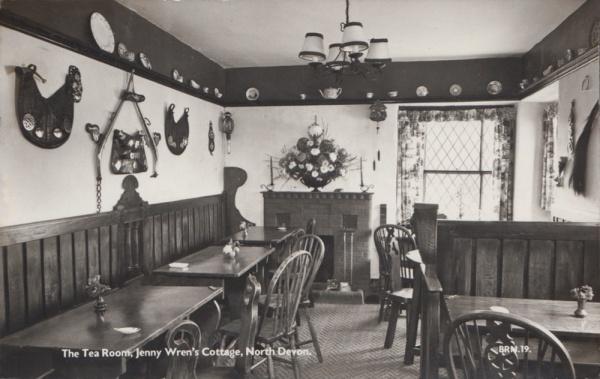

The Tea Room, Jenny Wren's Cottage, Braunton, North Devon. This card has proved to be a bit of a mystery. The photographer's code at lower right indicates that this is the 19th image taken in Braunton, a town in Devon. Jenny Wren is a common rural name for the House Wren, and is also the name of a character in Charles Dickens' 1865 novel "Our Mutual Friend." In the novel, Jenny Wren (whose real name is Fanny Cleaver) is a pretty but physically disabled young woman who cleverly supports herself and her alcoholic father as a dolls' dressmaker. Along the way she befriends a kindly Jewish man, and by the novel's end it is hinted that she has found love with an orphaned young man and that they may marry. "Jenny Wren's Cottage" is a popular name for small rural houses in England, and at the present time there is a cottage of that name in Knowle, a hamlet adjacent to Braunton. However, it is unclear to me if the current Jenny Wren's Cottage in Knowle, which is not a tea room, is indeed this cottage. In any case, whether the Tea Room at Jenny Wren's Cottage was named for the bird or for the lovably eccentric character in the novel, it is a charming little room with a cheery fireplace and diamond-mullioned windows, its walls festooned with a great deal of horse tack and a multitude of lucky horse brasses.
Moretonhampstead
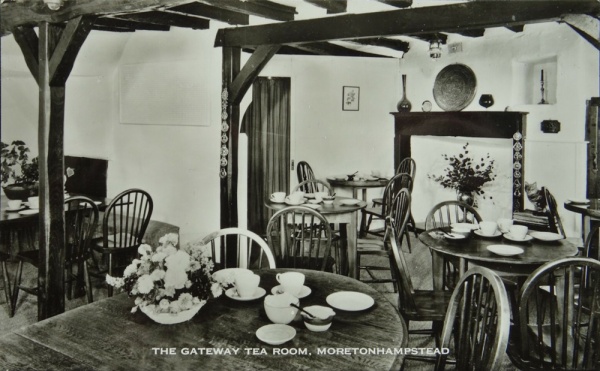
The Gateway Tea Room, Moretonhampstead, Devon, England. A bowl of white roses on a table and a large brass vase filled with blooming branches set into the fireplace hearth inform us that this photo was taken in summer. The wooden fireplace surround is quite similar to the 15th century fireplace in the Novelty Store Tea Room in the same town of Moretonhampstead, directly below. An array of antiquities adorns the mantelpiece and a leather strap strung with lucky horse brasses ornaments one side of the mantel frame.
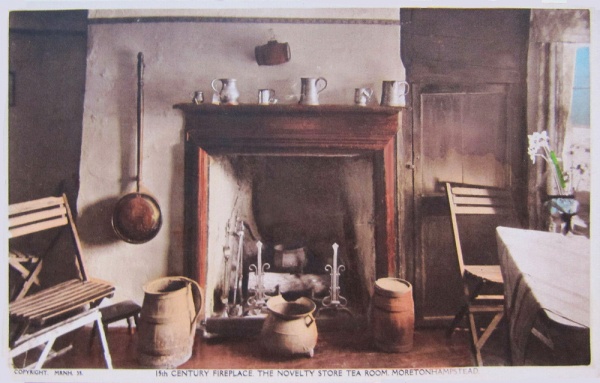
15th Century Fireplace, Novelty Store Tea Room, Moretonhampstead, Devon, England. Here is a card that mystifies me. It is strange enough for a Novelty Store to host a tea room, but how unlikely is it for the tea room to house a 15th century fireplace? In the English manner, the fireplace hearth is the center of attention in the tea room, and here we see the andirons, fire tools, brass warming pan, and a decorative array of pewter tankards on the mantelpiece. The tea table and garden furniture almost look like an afterthought, against the wall under a sunny window, ornamented with a casual vase of Narcissus flowers.
Woolacombe
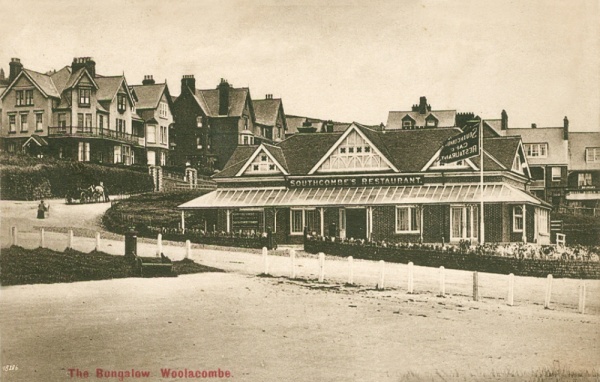
The Bungalow Tea Room, Woolacombe, Devon, England, also known as the Bungalow Café Restaurant, Southcombe's Restaurant, and The Red Barn. This description comes from the "North Devon Journal" of Thursday, May 31st,1906: "A new refreshment room was opened at Woolacombe on Monday by Mr. G. Southcombe of Ilfracombe. The building is a fine detached block, right in the centre of the village, and fronting to the sea."
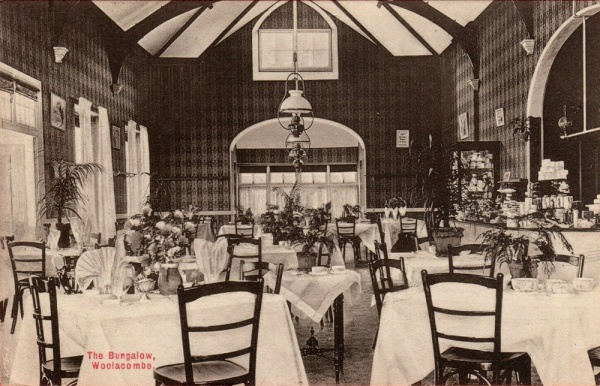

The Bungalow Tea Room, Woolacombe, Devon, England, also known as the Bungalow Café Restaurant, Southcombe's Restaurant, and The Red Barn. With its potted palms and fan-folded napkins, The Bungalow presents an upper-crust atmosphere akin to fancy hotel tea rooms of the era. Continuing from the "North Devon Journal" of Thursday, May 31st, 1906: "The principal room is a very fine one, 72 feet long, 25 feet wide, with an arched ceiling rising to 25 feet at the apex. It has four large windows in front, and at each end is a fine alcove with a large window, and there is also a window in each gable. In the centre opposite the entrance is a large semi-circular counter of polished wood, while the woodwork throughout the room is enamelled in white. The walls are covered with a tasteful art paper in green and red and the floor with artistic Staines linoleum. There will be accommodation at tables of various sizes for over 150 visitors, and every description of confectionary and refreshments will be served. The whole of the china used is of a very fine rose pattern. The room has two handsome fireplaces, and is lighted by six large lamps of the Veritas pattern. Opening out at the back of the room are lavatories for ladies and gentlemen, fitted with hot and cold water, and large mirrors. From the back of the counter are reached the store room, having ten large cupboards, the dairy and larder, kitchen, wash up room, and sitting room, while bedrooms are provided above. There is a back entrance to the premises, and along the whole frontage is a verandah, six feet wide. Beneath the dining room and entered from outside is a cycle rest, where a good number of cycles can be stored. Mr. G. Southcombe, Junior, takes charge of the business, which provides accommodation of the most modern kind, hitherto lacking in this favourite resort for day visitors. We wish the new venture every success."
Gloucestershire
Tewkesbury
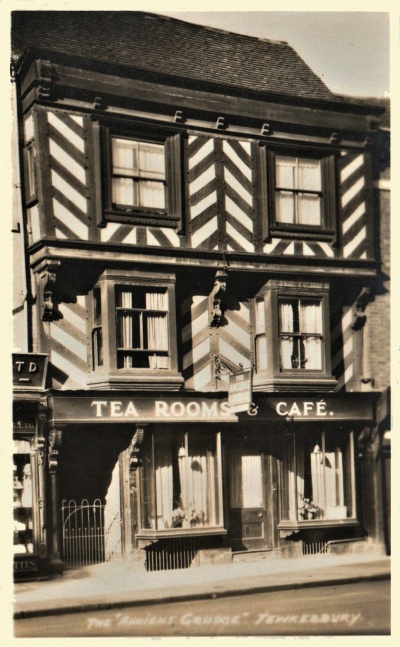
The "Ancient Grudge" Tea Rooms and Cafe, Tewkesbury, Gloucestershire, England. The "Ancient Grudge" was the enmity between the Houses of York and Lancaster, which brought about the Battle of Tewkesbury in 1471. I grew up in California, where we call this style of half-timbered architecture "Tudor," but ours is only Pseudo-Tudor; this is the real deal, built in the early 16th century and re-fronted in the late 16th century. The building, at 15 High Street, still stands.
Greater London
London
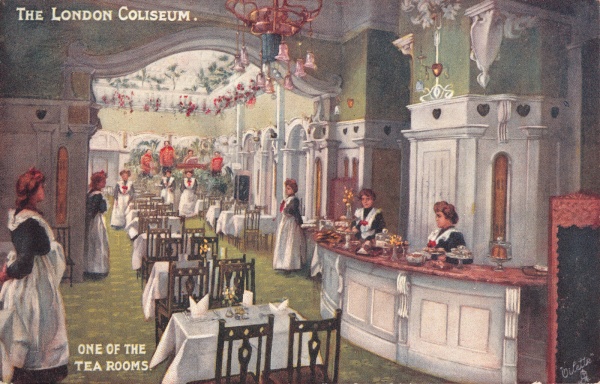
The London Coliseum, One of the Tea Rooms. The London Coliseum, in St. Martin's Lane, Westminster, opened in 1904 as London's largest and most luxurious music hall, seating 2,359 patrons. The uniformed waitresses stand ready to serve a crowd of happy theatre-goers. I wonder how many tea rooms there actually were. The building, designed by the architect Frank Matcham, still stands and is now the home of the English National Ballet. This is a Tuck Oilette, a small reproduction of an oil painting that was commissioned by Raphael Tuck and Sons, a famous postcard company.
Hampshire
Beaulieu
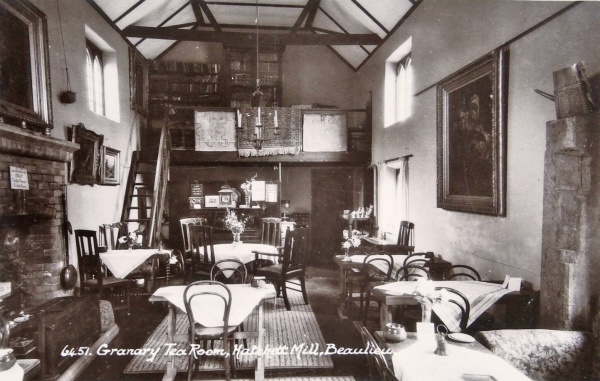
Granary Tea Rooms, Hatchett Mill, Beaulieu, Hampshire, England, postcard front. This image, number 6451, looking into the room from the door, has been shot at 180 degrees from the following card. A massive fireplace along one wall is not the focus of attention in this narrow room. A steep stair-ladder leads up to a mezzanine or loft lined with book shelves, whose balustrade is hung with fancy carpets. The text on the back identifies it as a Real Photo in the "Sunshine" Series, photographed and printed by E. A. Sweetman and Son, Tunbridge Wells The notation of a "Son" would seem to indicate that this is from a later printing than the following card, although the photos were taken on the same day and sequentially numbered.
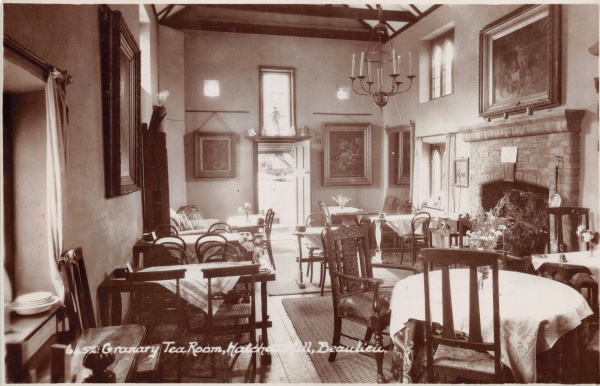
Granary Tea Rooms, Hatchett Mill, Beaulieu, Hampshire, England, postcard front. This image, number 6452, is taken from inside the tea room, looking back at the door, and was shot at 180 degrees from the previous card. Here we see the entirety of the large fireplace and the array of eight or ten tea tables decked with starched linens and casual vases of summer flowers. The text on the back informs us that it is a Real Photo Post Card by E. A. Sweetman Ltd., Tunbridge Wells.
Burley
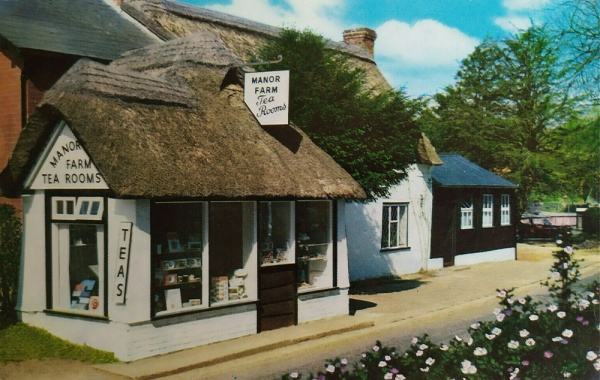
Exterior of Manor Farm Tea Rooms, Burley, New Forest, Hampshire, England. The ancient thatched cottage dates to the 16th century, according to the text on the back of this colour photo postcard from 1945. Directly below is an interior shot of the old fireplace.
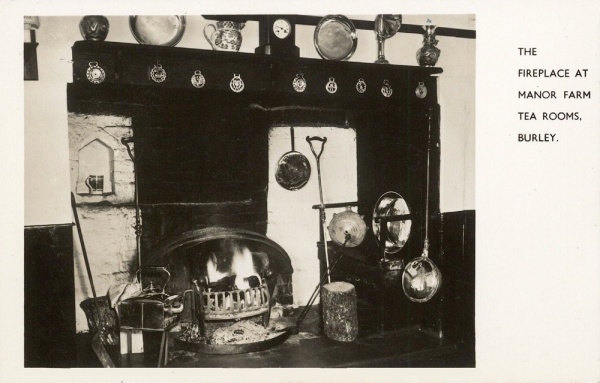
The Fireplace at Manor Farm Tea Rooms, Burley, New Forest, Hampshire, England. The tea tables are not seen, but the focus is on a very ancient fireplace around which we see a grouping of fire tools, polished brass warming pans, an unusual rectangular brass tea kettle, and some firewood. Along the front of the mantelpiece, nine lucky horse brasses are nailed; atop the mantel a clock, two brass trays, an ornate candle-stand, and some pottery can be seen; one piece seems to be a jug in the old Blue Willow pattern.
Ringwood
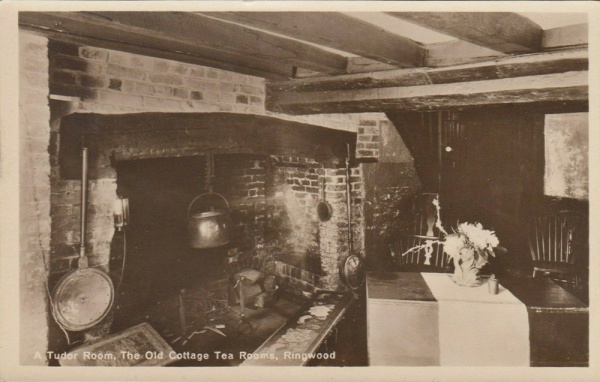
A Tudor Room, Old Cottage Tea Rooms, Ringwood, New Forest, Hampshire, England. The plural form, "Tea Rooms" is quite common in England and is used specifically to convey the information that a multi-roomed building — perhaps an old home, historic agricultural structure, or a shop — has been outfitted with several small tea rooms, each featuring its own decor. This is "a Tudor Room," and as is often the case, the photo features an old fireplace. Here we see the andirons, fire tools, brass warming pans, and kettle -- but no cheerfully flaming logs or grate of coal, because as the vase of flowers tells us, the photo was taken in summertime.
Kent
Hildenborough
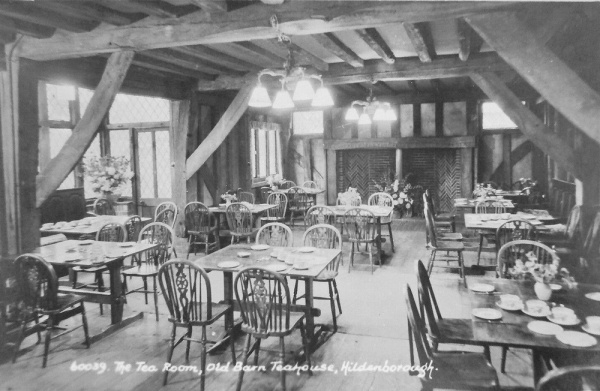
The Old Barn Tea House, Stock's Green, Hildenborough, Kent, England. The magnificent wooden beams and massive brick fireplace of the Old Barn, set about with large vases of summer garden flowers, make this tea house a glorious destination for a day-trip.
Maidstone
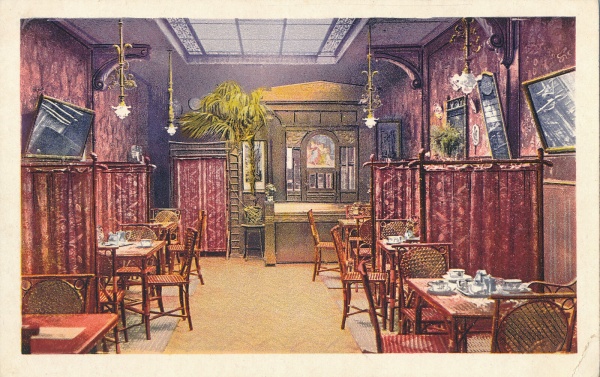
The Grande Confiserie Tea Room, Maidstone, Kent, England. A confiserie or confectionary is a shop that sells sweets. The Grande Confiserie set aside a small area just big enough for six tables, and outfitted it as an extravagant Chinese-style tea room, with beautiful rattan furniture, brocade screens, hanging lamps, and a potted palm. The opulence is all in the eye, of course; imported furnishings such as these could have been had inexpensively, and the downward-hanging mirrors add the illusion of space. I salute the skilled designer who brought this exotic fantasy room to life.
Surrey
Epsom
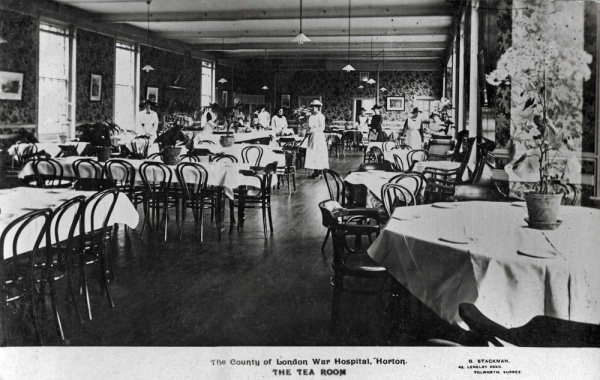
Horton County of London War Hospital Tea Room, Horton Hospital, Long Grove Road, Epsom, Surrey. This institution opened as a mental asylum on the 88 acre Horton Estate in 1902, and was converted to a hospital for wounded British soldiers in 1915, during World War One; note that the tea servers seem to be dressed as volunteers, in a variety of outfits.
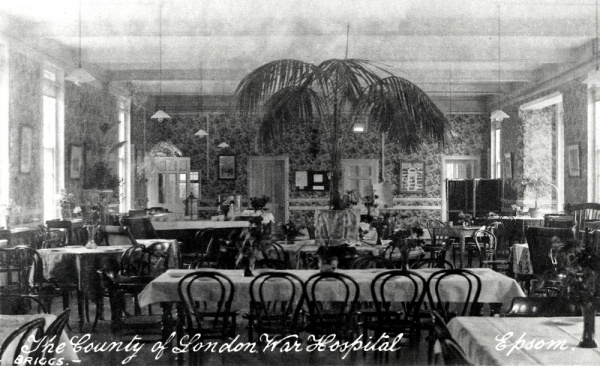
Horton County of London War Hospital Tea Room, Horton Hospital, Long Grove Road, Epsom, Surrey. Although not captioned as such, this is more or less a reverse view of the above card. King George V and Queen Mary visited the hospital in July 1916, at which time there were almost 2000 military patients; in 1919, after having served more than 46,000 soldiers, Horton was handed back to civilian authorities; it was reinstated as a mental hospital and renamed Horton Mental Hospital in 1920
Sussex
Alfriston
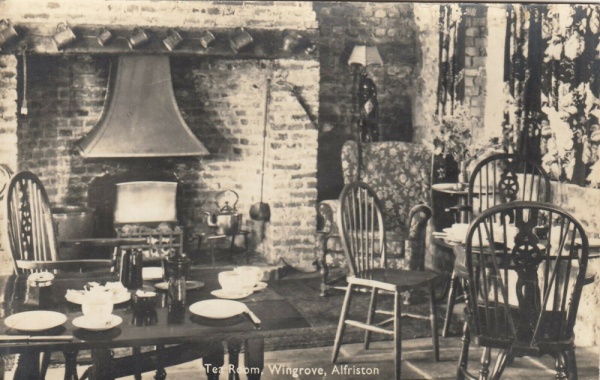
The Wingrove House Tea Room, Alfriston, East Sussex, England. This building has housed a hotel, tea room, and restaurant for at least 100 years, and is still in operation, although the interior has been remodelled. In this circa 1930s - 1950s photo we see the usual British focus on the fireplace, fire tools, antique warming pans, and kettle. Hung from nails on the mantel is a row of antique pewter tankards.
"Possibly in Sussex"
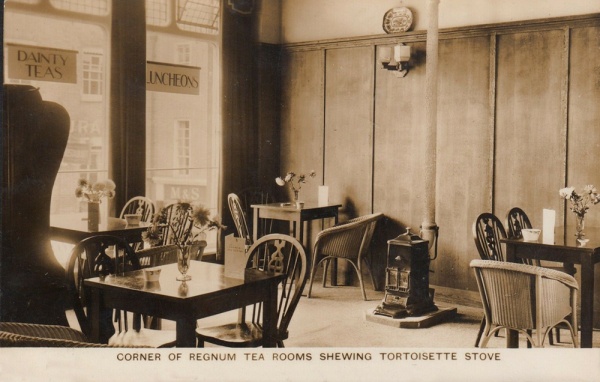

Regnum Tea Rooms Shewing Tortoisette Stove, Unknown Town, "Possibly in Sussex," England. Well, this is one of those cards that resists research. I purchased it from a dealer in the UK who, for reasons known to himself, pencilled on the back, "Possibly in Sussex," and so here it is. No tea room of this name currently can be found in England, and this photo must date to the mid or late 1930s. Which brings me to the second great unknown: lacking a cozy fireplace, the Regnum Tea Rooms makes do by boasting of its "Tortoisette Stove." I pondered this mystery for many a year, but in due time, the internet came along, and the Tortoisette Steve proved very easy to research. To make a long story short, in the 19th century, Charles Portway designed an extremely slow-burning fuel-efficient cast iron stove that could handle soft woods, hard woods, peat, straw, sawdust briquettes, anthracite, and lignite coal. He named it the Tortoise, and its motto, "Slow but Sure" was displayed on the front of every stove. In the 1930s a smaller version of the Tortoise was introduced, and it was called, logically enough, the Tortoisette. Several models were made; this is the Tortoisette Model 2, now a much-loved and highly collectible antique. The Portway company is still making stoves, by the way, and they come with a ten-year guarantee. As for the Regnum Tea Rooms, we have a mix of rattan and wooden seating, abundant summer flowers in vases, an art deco light fixture, an antique pottery platter, signage advertising "Dainty Teas" and "Luncheons," and not much else. If you know where it was located, drop me a line; i'd love to get it properly situated in the Land of Tea.
Wealden
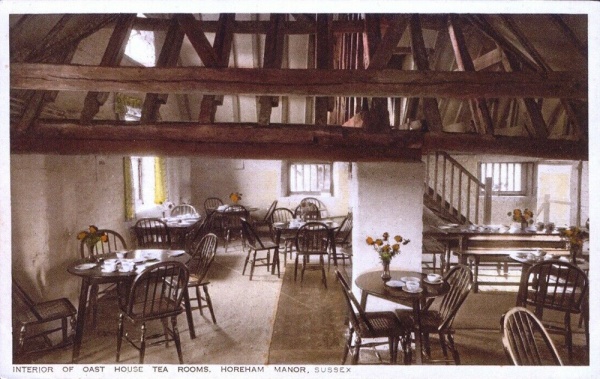
Oast House Tea Rooms, Horeham Manor, Wealden, East Sussex, England. Horeham Manor was built in the 17th century, but underwent several waves of remodelling and repurposing, at one point being converted to use as a farm, and, by the early 20th century, a hotel. In an article titled "Old Horeham Manor" in "Sussex County Magazine," Vol. 3, 1929, we learn that the manor was at that time owned by Mr. and Mrs. Lindsay, who ran it as a residential hotel known as Manor House Hotel, and that there were lakes with flamingos, water fowl, and swans on the property.
Warwickshire
Kenilworth
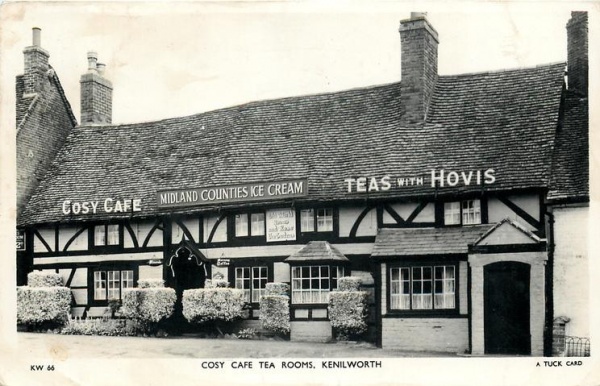
Cosy Cafe Tea Rooms, Kenilworth, England. This, card, KW 64, is an exterior shot in a series of Raphael Tuck and Sons postcard views of Kenilworth.
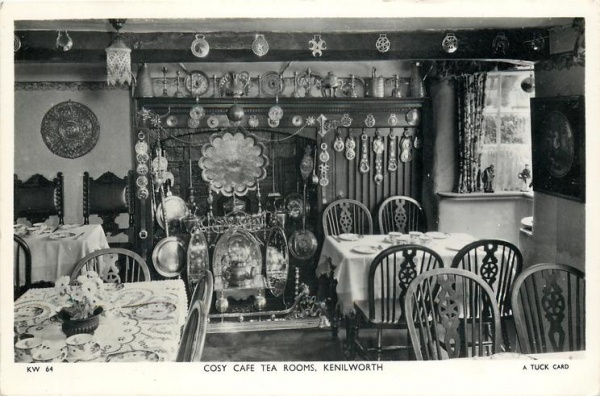
Cosy Cafe Tea Rooms, Kenilworth, England. This, card, KW 66, is another Tuck Card in the Kenilworth series, showing the interior of the Cosy Cafe Tea Rooms. The collection of horse brasses is delightful; notice also the china ware.
Worcestershire
Broadway
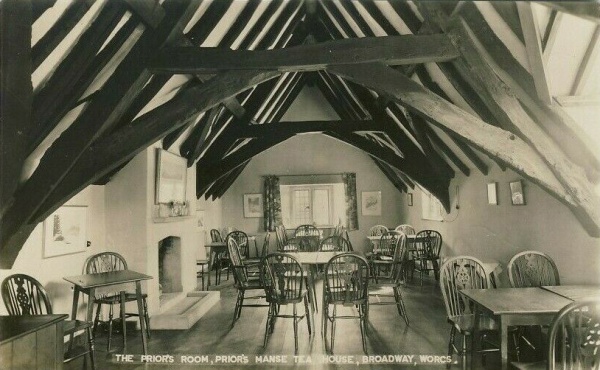
The Prior's Room, Prior's Manse Tea House, Broadway, Worcestershire, England. The fireplace in this gable-ceilinged upper room is not lit, but its mantel holds a nice array of antique porcelain ewers and jugs, in what may be the Blue Willow pattern. The antique-style wooden chairs set off the ceiling beams beautifully.
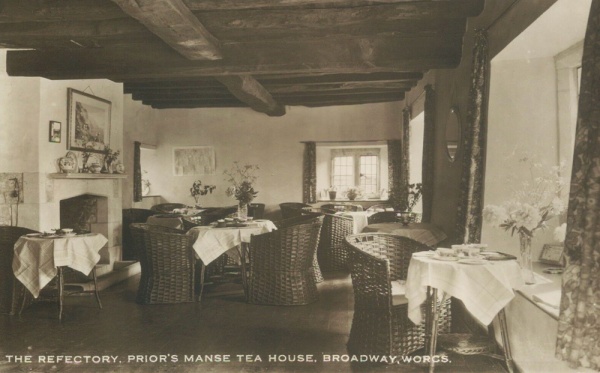
The Refectory, Prior's Manse Tea House, Broadway, Worcestershire, England. The fireplace in the lower room, the manse's former dining hall, is almost identical to the one above. Again no fire is lit, but here we see why -- the beautiful vase of blooming white roses in the window sill and the floral sprays on the tables and mantelpiece show this photo to have been taken in summer, on a sunny day. As above, a show of china-ware decorates the mantel, and in this image it more clearly seems to be in the much-loved Blue Willow pattern, which, with its Asian theme, ties tea-drinking to "The Land of Tea." Rattan chairs, also Asian in origin, evoke a style of early 20th century tea room decor more commonly found in California than in England.
catherine yronwode
curator, historian, and docent
The Mystic Tea Room
See Also





















